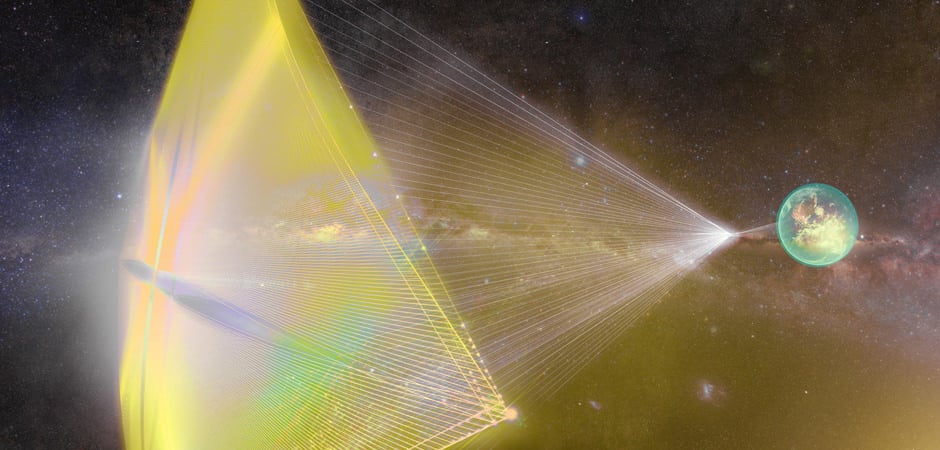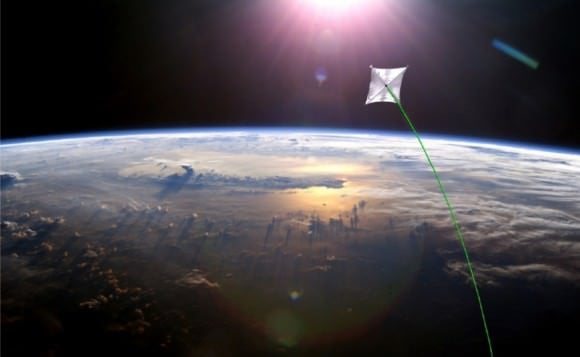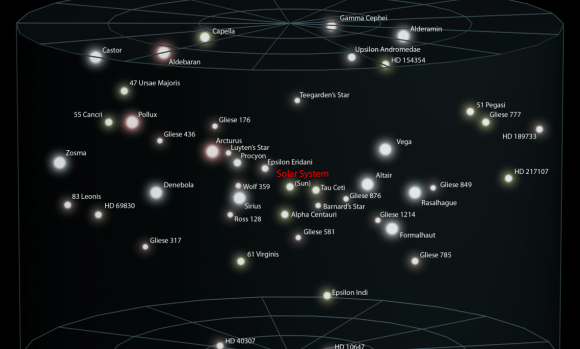For generations, human beings have fantasized about the possibility of finding extra-terrestrial life. And with our ongoing research efforts to discover new and exciting
extrasolar planets
(aka. exoplanets) in distant star systems, the possibility of actually visiting one of these worlds has received a real shot in the arm. Unfortunately, given the astronomical distances involved, not to mention the cost of mounting an expedition, doing so presents numerous significant challenges.
However, Russian billionaire Yuri Milner and the
Breakthrough Foundation
- an international organization committed to exploration and scientific research - is determined to mount an interstellar mission to Alpha Centauri, our closest stellar neighbor, in the coming years. With the backing of such big name sponsors as Mark Zuckerberg and Stephen Hawking, his latest initiative (named "
Project Starshot
") aims to send a tiny spacecraft to the Alpha Centauri system to search for planets and signs of life.
Consisting of an ultra-light nanocraft and a lightsail, the concept calls for a ground-based laser array to push the lightsail up to speeds of hundreds of kilometers a second, towing the nanocraft into deep space. Such a system would allow the tiny spacecraft to conduct a flyby mission to Alpha Centauri in about 20 years after it is launched, which could then beam home images of possible planets, as well as other scientific data such as analysis of magnetic fields.
In essence, Starshot seeks to leverage recent technological developments to mount an interstellar mission that will reach another star within a single generation. As we explained in another article ("
How Long Would It Take To Travel To The Nearest Star?
"), using existing technology, it would take between 19,000 to 81,000 years for a spacecraft to make the trip to even the nearest star, depending on whether chemical rockets or ion engines were used.
[caption id="attachment_106626" align="aligncenter" width="580"]
Artist concept of a solar sail demonstration mission that will use lasers for navigation. Credit: NASA.
[/caption]
Hence, the Foundation's advisory board explored all potential methods for creating a craft that could travel at relativistic speeds - up to 20% the speed of light - so it could traverse the 4.37 light year distance in just 20 years. They determined that a tiny craft, roughly the size of a refrigerator magnet and weighing in the vicinity of a few grams, would be the best model for a spacecraft. They further determined that the best propulsion method would be laser-driven lightsail, which is not hampered by the limits of conventional methods.
With a massive ground-based laser directing the sail, the plan is to accelerate the nanocraft to its terminal velocity before it reaches a distance of about one million km from Earth (which is the limit to which the laser beam can be focused on the meter-scale sail). All told, the nanocraft will experience an acceleration of about 60,000
g
(sixty-thousands times the force of Earth's gravity, which works out to just under 600,000 m/s²).
As Professor Avi Loeb, the
Frank B. Baird, Jr. Professor of Science at Harvard University and
chairman of the Foundation's Advisory Board, explained to Universe Today via email:
[caption id="attachment_98035" align="aligncenter" width="580"]
Artist's impression of the planet around Alpha Centauri B. Credit: ESO
[/caption]
In addition to accomplishing the dream of countless generations (i.e. traveling to another star system), Breakthrough Starshot hopes to generate important supplementary benefits to astronomy in the meantime. Much like the
Apollo Program
of the 1960s, the Breakthrough Starshot program hopes to stimulate the development of technologies that will be beneficial here on Earth.
These include demonstrating proof-of-concept technology that will enable the exploration the solar system, the detection and study of
Near Earth Objects
(NEOs), and the benefits to material science that solar sail development will bring. The development of laser arrays will also have major implications for the science of optical systems, and the laser communication devices used on Starshot will likely lead to better communication with airplanes and satellites around Earth.
As Pete Worden, the Executive Director Project Breakthrough StarShot, told Universe Today via email:
[caption id="attachment_128441" align="aligncenter" width="580"]
Artist's concept for the Directed Energy Propulsion for Interstellar Exploration (DEEP-IN) laser sail concept. Credit: UCSB Experimental Cosmology Group
[/caption]
Based on the Foundation's best estimates, this project could achieve its goal of dispatching their interstellar traveler within a few decades time. And with a 20 some-odd year transit time, we could be gaining vital information about the nearest star system (including whether or not it has life-supporting exoplanets) by the 2050s or 2060s.
Naturally, there are still several engineering hurdles that would need to be overcome before Starshot can become a reality. For example, propelling a gram-scale spacecraft to 20% the speed of light will require a laser beam of that could generate about 100 Gigawatts of power over the course of a few minutes. The Project intends to build this laser array on the ground, simply because that would be much cheaper than building one in space.
This, in turn, creates the challenge of optical-blurring due to atmospheric turbulence. Using adaptive optics (measuring atmospheric effects and correcting for them) is believed to be able to compensate for that. Such a method has been tested on the scale of the largest telescopes (10 meters in diameter), but would need to be tested on a scale of 1 km before it can be considered feasible.
What's more, there are plenty of doubts as to the missions intended target, not to mention the likelihood that the mission will succeed. For instance, while Alpha Centauri may be the nearest star, thus making it the natural choice for interstellar exploration, there is little reason to suspect we will find any exoplanets there.
[caption id="attachment_128444" align="aligncenter" width="580"]
A phased laser array, perhaps in the high desert of Chile, propels sails on their journey. Credit: Breakthrough Initiatives
[/caption]
Years back, astronomers announced the detection of a possible planet circling Alpha Centauri B with an orbital period of 3.24 days - which was named
Alpha Cen Bb
. However,
subsequent examinations
revealed that the detection of this exoplanet was the result of the window function (time sampling) of the original data. If we hope to find exoplanets, then we might need to look further afield - like
Epsilon Eridani
, a mere 10.5 light years away (which would result in a travel time of 55 years for the proposed nanocraft).
And, as Paul Gilster of
Centauri Dreams
points out, the concept presents numerous challenges that will require technical advances not currently in existence. For example, beyond the issue of laser power and adaptive optics, there are issues with the sail concept itself that are likely to prove difficult. Essentially, this comes down to the need for a balance to be struck between powerful lasers and a sail that is capable of withstanding them:
Addressing the design called for by Breakthrough Starshot - a thin, round disc that is about the size of a picnic table in diameter, and which would have its entire electronics suite in the center - Gilster sees additional problems. "We've also got a problem in that concept," he says, "because Jim Benford has pointed out that a flat sail is not a good 'beam-rider' - we'll likely have to look at the kind of curved sail designs both Jim and brother Gregory Benford have studied in lab work at the Jet Propulsion Laboratory."
[caption id="attachment_128436" align="aligncenter" width="580"]
The relative locations of some famous stars, relative to the sun. Credit: Andrew Z Colvin
[/caption]
In the end, the only reason to send a probe to Alpha Centauri is because of its proximity. And mounting the mission will require that the Breakthrough Foundation and its supporters come up with new and innovative solutions to the hurdles they face. But given that the opportunities for research and exploration will still be abundant, the reasonable timelines involved, and the likelihood of success, the mission certainly appears to be doable.
Previous efforts by the Breakthrough Foundation's include
Breakthrough Listen
, the largest scientist research program aimed at detecting transmissions from distant stars. These include monitoring for radio transmissions and optical laser transmissions using advanced instruments that are significantly more sensitive than anything currently in use, combined with advanced software and data analysis. The program will span 10 years and cost an estimated $100 million, surveying the 1,000,000 closest stars to Earth and the 100 closest galaxies to the Milky Way.
There's also
Breakthrough Message
, a $1 million competition aimed at encouraging a global debate about the ethics and possible methods of communicating with possible intelligent beings beyond Earth. The competition is open, and the prize will be awarded to anyone who is able to design a message (in digital format) that best represents Earth and humanity to other civilizations.
And be sure to enjoy this video from the Breakthrough Foundation that illustrates the mission concept:
Further Reading: Breakthrough Initiatives
 Universe Today
Universe Today





